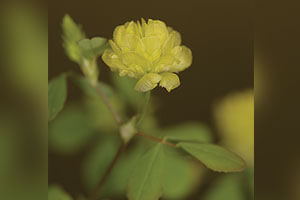
Scientific name: Trifolium campestre (Hop clover, field clover) and Trifolium aureum (Large hop clover, golden clover). In the beekeeping literature, these two species are frequently handled together. This is the way I handle them here.
Synonyms: Hop clover: Trifolium campestre was once called Trifolium procumbens.
Large hop clover: Trifolium aureum was once called Trifolium agrarium.
Origin: Hop clover: Eurasia: (Europe and the entire Mediterranean region). The species has subsequently been introduced into the Eastern US and Canada.
Large hop clover: Eurasia: most of Europe east to Turkey and the Caucasus region. It also has subsequently become widely naturalized in the US and Canada.
Plant descriptions:
Hop clover (Trifolium campestre) is generally an annual, sometimes a biennial, 5 cm to 30 cm (~1.97 to 11.8 in) tall, is erect with ascending branches that can be either hairless or hairy. The stipules1 are ovate, pointed, and usually about half the length of the leaf stem.
The three leaves are about 2 cm (~0.79 in) long, the terminal leaflet is on a stem, the other two are without stems. The leaves are generally placed alternately on the plant with the upper ones placed nearly oppositely. The leaflets2 are 0.8 to 1.5 cm (~0.31 to 0.59 in) long and 0.4 to 0.8 cm (~0.16 to 0.32) wide and range in shape between obovate3 to elliptical. The leaflet tip is blunt or even indented and the leaves are finely toothed in their upper region.
The flowering heads are made up of about 20 flowers, are ovate to nearly spherical and 1 to 1.5 cm (~0.39-0.59 in) long and 0.7 to 1 cm wide (~0.28 to 0.31 in). The individual flowers are about 1 mm (~0.04 in) long, the calyx4 is white and at most only slightly hairy, and is bell shaped with the upper teeth shorter than the others. The flower itself is yellow, ‘spoon shaped’ and possesses a finely toothed margin and dark parallel lines. The seed pods are about 2 mm (~0.78 in) long and contain a single seed.[2]
Large hop clover (Trifolium aureum) is an erect annual or biennial with or without branches, and is at most only a slightly hairy annual 20 to 60 cm (~7.9 to 23.6 in) tall. The stipules are lance-shaped, pointed, and about equal in length to the leaf stem. The three leaflets are 1.5 to 2.5 cm (~0.59 to 0.98 in) long, are obovate to elliptical to oblanceolate in shape, are finely toothed and have no leaflet stems. The leaves have short stems that are about as long as or only slightly longer than the stipules.
The flowering heads are either terminal or arise from the angle between the main stem and a leaf stem. They are egg-shaped (ovoid), 1.5 to 2 cm (~0.59 to 0.79 in) long and 1 to 1.5cm (~0.39 to 0.59 in) wide and contain 20-50 florets. The florets are 7 to 8 mm (~.0.28 to 0.31) long and are on stems 1 mm (~0.04 in) long and at their attachment points are surrounded by small leaf-like structures (bracts).
The calyx is 3mm (0.12 in) long and the floral tube is up to 1mm (~0.04 in) long. The largest petal (the standard petal) is concave and becomes brown and lined with age.
The seed pods are 2 to 3 mm (~0.08 to 0.12 in) long, contain a single seed, and are borne on a short stem..[2]
The broad somewhat ovate stipules of T. campestre can help distinguish it from T. aureum with its prolonged lanceolate-ovate stipules.[11]
There are relatively few yellow clovers. Gillett and Taylor[2] by my count, list and describe 228 clover species. Relatively few of them have yellow or yellowish flowers and some of these can have other colors as well, sometimes changing to these colors (most commonly pinks or purples) with age.
Distribution: Hop clover: Roadsides and fields. Large hop clover: Roadsides and fields and forest openings.[2]
Blooming period: Hop clover: In the US. the blooming period is generally confined to August to October; Large hop clover: primarily July to August.[2]
Importance as a honey plant: Oertel[7] from his questionnaires found Trifolium agrarium (here called T. aureum) to be of some importance in LA. Ayers and Harman[1] from their questionnaires found…


